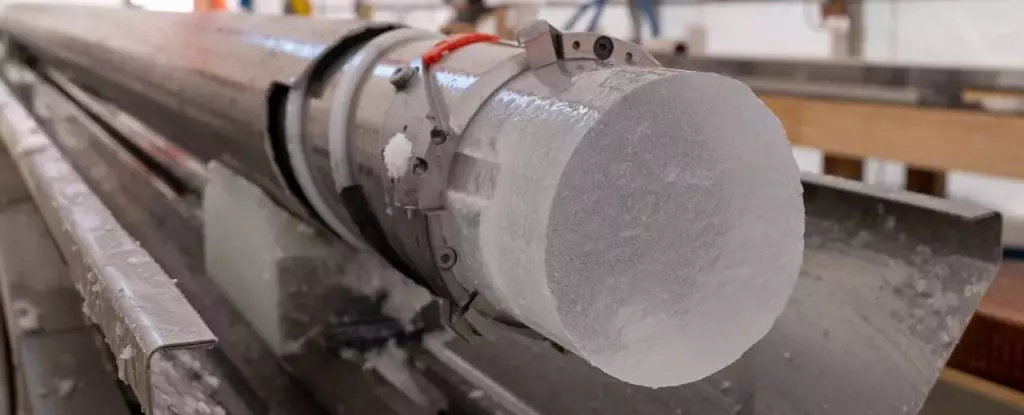The study of Earth’s climate history has never been more crucial than it is today, given the accelerating impact of climate change. Scientists have recently drilled a remarkable ice core sample in Antarctica, presenting an unprecedented opportunity to explore more than a million years of climate data. This colossal undertaking has yielded invaluable information, potentially influencing our understanding of past climate extremes and offering a clearer perspective on the present-day crisis.
Measuring an astounding 2,800 meters (about 9,186 feet), this ice core has significance that extends beyond its size. If laid out flat, it could span the length of San Francisco’s iconic Golden Gate Bridge. Each meter of this ancient ice encapsulates around 13,000 years of compressed history, including trapped air bubbles that give a glimpse into the atmosphere of millennia past. As Julien Westhoff, the chief scientist for the European Project for Ice Coring in Antarctica (EPICA), explains, significant portions of this ice core may contain continuous records dating back 1.2 million years.
Notably, while previous ice cores have only captured approximately 740,000 years of history, this new discovery brings the potential to uncover even older climate records. There lies a tantalizing possibility that the deepest layers could date back to the pre-Quaternary period, over 2.5 million years ago. Such information could reshape our understanding of Earth’s historical climate patterns while offering critical context to current climate trends.
Ice cores are not merely frozen artifacts; they serve as time capsules, preserving chemical signatures of bygone eras. Scientists can analyze the trapped gases—primarily carbon dioxide and methane—to recreate historical atmospheric compositions. These findings allow for a reconstruction of climatic conditions and the environmental challenges faced by early human populations. The new core from East Antarctica holds particular intrigue as it covers a timeframe when the Earth underwent prolonged glaciation cycles, an event whose causes remain elusive.
Some researchers theorize that during this epoch of intense cold, around 900,000 to 1.2 million years ago, nearly 99 percent of early humans in Africa may have faced extinction. This hypothesis may seem contentious and rests primarily on genetic data from modern humans, yet it highlights the dire consequences that climate change has historically had on humanity’s survival.
As scientists peel back the layers of this ice core history, they are also poised to confront the reality of anthropogenic climate change. The core timeline can shed light on how far current human activity has diverged from natural climatic cycles. Carlo Barbante, EPICA’s director, emphasizes the importance of understanding the intricate interplay between greenhouse gas concentrations and global temperatures over the last 1.2 million years, with an eye towards applications in addressing today’s climate crisis.
This ice core analysis not only reinforces the urgency of addressing climate change but also highlights the scientific mysteries that remain unsolved. The transition between glacial and interglacial periods is critical for understanding how current greenhouse gas concentrations are affecting our planet. With real-time isotopic analysis capabilities during the drilling process, researchers will be able to extract valuable climate insights more efficiently than ever before.
The recent drilling took place at Little Dome C in East Antarctica, an area identified for its thick layers of ice—layers that had not yet undergone significant melting. However, this mission came with its own set of challenges. Situated at 3,200 meters above sea level and subjected to extreme cold, reaching average summer temperatures of -35 °C (-31 °F), conducting research in such an unforgiving environment required immense logistical coordination and effort.
Researchers spent extensive time transporting equipment and supplies from nearby research stations, illustrating both the commitment and the complexity involved in conducting groundbreaking climate science in remote locales. Climate scientist Richard Alley, although not part of the project, has praised the effort, calling the EPICA ice core “truly, truly, amazingly fantastic,” a clear indication of its potential to yield groundbreaking discoveries.
Ultimately, the insights garnered from this colossal ice core could transform our understanding of Earth’s climate history and its ongoing evolution. As humanity grapples with the urgent issue of climate change, such research underscores the importance of historical context in formulating effective strategies for climate mitigation. By unlocking the secrets frozen within Antarctica’s ice, we not only learn about our past but also glean critical information that may prove vital in determining our planet’s future.


Leave a Reply